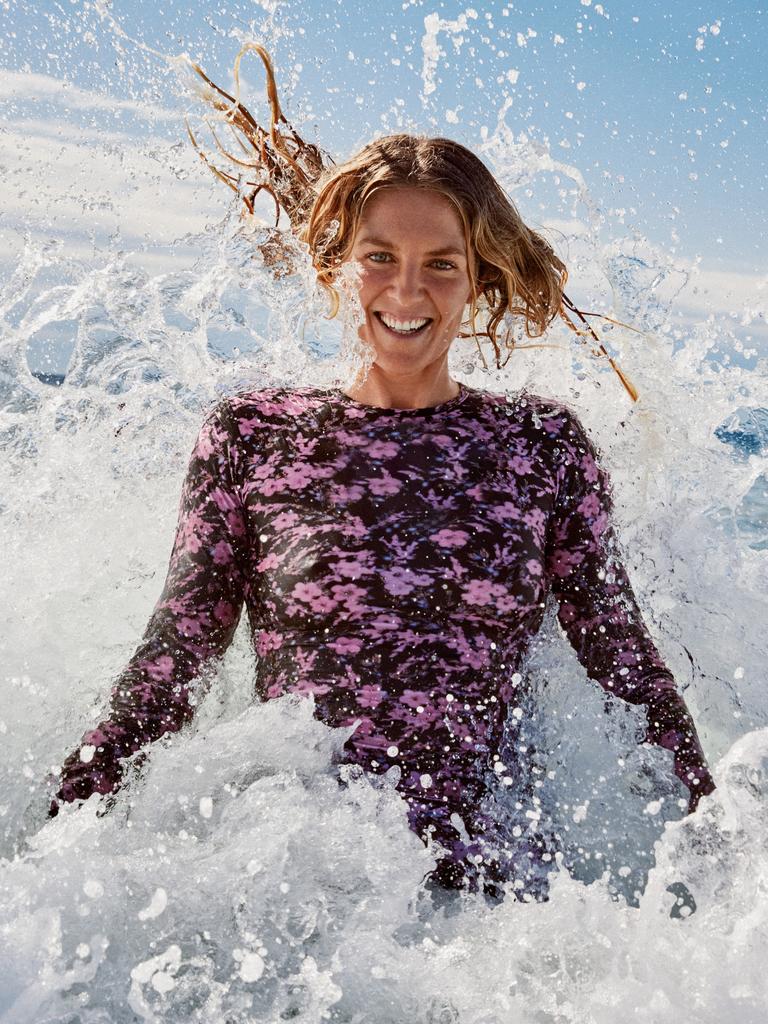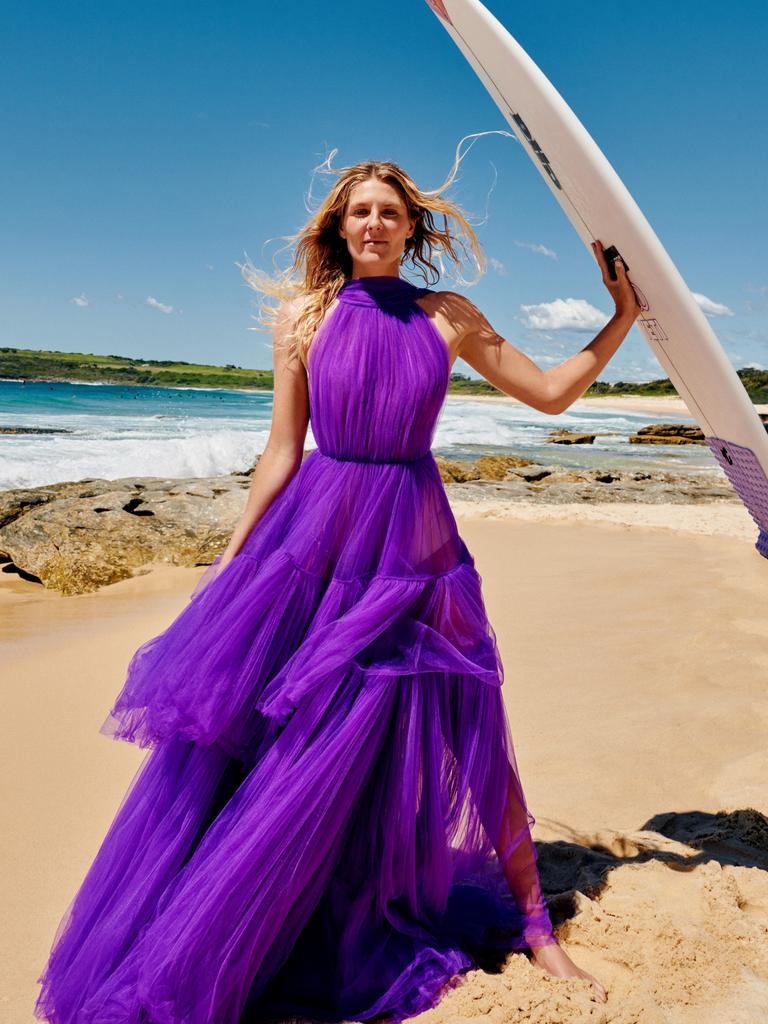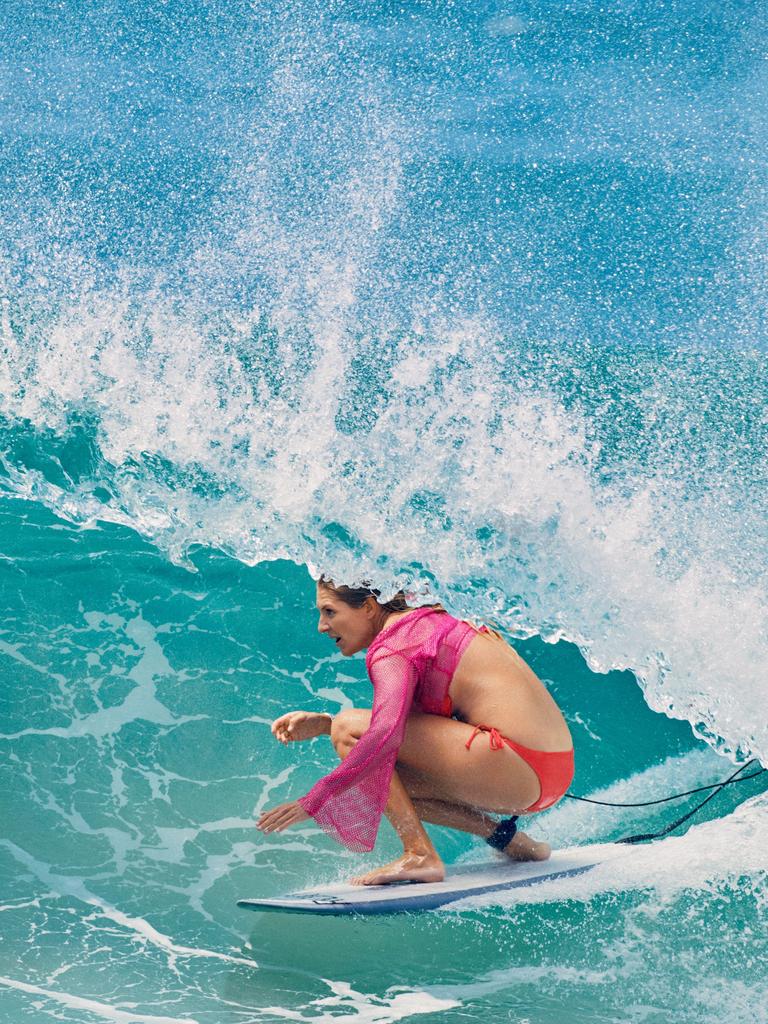Why Stephanie Gilmore almost called time on surfing
After a string of bad luck, world champion surfer Steph Gilmore almost threw in the towel - but one thing stopped her.
Coming into the final round of this year’s world surfing championships, Stephanie Gilmore was far from the favourite to win. Positioned last (and the oldest) in the top five, the Australian battled her way up through the heats to defeat the reigning champion and take out her eighth world title – cementing her status as the greatest female surfer of all time. As she joins Stellar for a cover shoot at a picture-perfect beach – and, of course, on the waves – Gilmore reflects on the challenges of being a woman in the industry she loves, the insecurity and intimidation even someone like her feels paddling out into the water, and the mindset she harnessed to come back from almost debilitating adversity. As she says: “I had to find self-belief again”
For Stephanie Gilmore, a professional surfing career has brought with it an expected perk or two – such as invites to fabulous, lavish parties and plenty of opportunities to travel the world.
Ironically, the one thing it definitely does not do is make it any easier for her to catch
a wave when she’s not in competition.
“A lot of people think that you’ll be able to paddle out into a crowd of surfers and they will part and you can take whatever wave you want,” Gilmore tells Stellar. “But it’s not like that.
“The free surfers are like, ‘You get to surf all day. We have to go to work. So we’ll take as many waves off you as we can.’”
Gilmore adds that, because jumping into the ocean costs nothing and surfers of all stripes must share the waves with everyone, fans don’t get starstruck when they see her next to them in the water.
“We’re more connected to our fans in a way that other athletes and rock stars aren’t because they are competing and training in private locations,” she explains.
“Even in the biggest events of the year, surfers can paddle out and sit next to you. There are no boundaries. I think that keeps surfing – and surfers – at a real humble level.”

So on a recent Monday morning at Maroubra Beach in Sydney, in an ocean packed with grommets and pre-work riders, the greatest female surfer of all time patiently waited for her turn to catch a wave during her Stellar photo shoot.
All the while, she was wearing something a bit more elevated than her usual competition gear: a strapless, bright yellow mini dress covered in playful banana-shaped embellishments.
On reflection, a couple of days after the shoot, Gilmore muses, “It’s pretty cool that I’m able to try to surf in a beautiful dress. For most of my life I was such a tomboy, and couldn’t stand the idea of having to wear dresses.
“But I’ve watched other female athletes like Serena Williams be fierce and feminine, and I feel like the older I get, I realise how fun it is to embrace both sides.
“I’m lucky that surfing is a creative sport,” she continues. “We aren’t judged over who gets across the line fastest. It’s subjective.
“Everyone has a different personality on the waves and, for me, my favourite surfing to watch – male or female – [has] a gracefulness to it. It’s a blend of masculine and feminine. They dance with the ocean. It’s a beautiful performance.”
Neither the gathering crowds who recognised her, nor the unseasonably cold weather, and certainly not that designer dress, could stop the woman who goes by the nickname “Happy Gilmore” from dancing up a storm with the ocean as she skilfully posed for the camera that day.
In much the same way, a last-place position in the final round and against-the-odds conditions didn’t stop 34-year-old Gilmore from winning her eighth World Surf League title in California in September.
When the floral crown was put on her head, Gilmore eclipsed fellow Australian Layne Beachley (with seven world titles) to become the most decorated female surfer in history.
Only Kelly Slater, the American who holds 11 titles, has won more than her.
While she is known for her grace on the water, it was the guttural roar she let out when she reached dry land that indicated how hard-won the victory was.
“I had a really tough year,” says Gilmore. “I missed the first event from Covid. I had a shocker in the second event.
“I started thinking, do I even persevere with this season?” she admits.

With stage wins becoming rarer and the competition fiercer in years prior, Gilmore reveals to Stellar that she had resigned herself to the fact she might never win her historic eighth title.
“I hadn’t thought about hanging it up but [after losing in 2021] I was definitely considering what my career would look like if it finished at seven,” she remembers.
“And that’s not a bad thing – because I’ve had an incredibly successful career. But I think that was my fear coming in, and it sort of removed a bit of my fire.”
However, after scraping her way into the finals, while still in last position, Gilmore figured she had nothing to lose.
“At that moment, I could see both sides of the story, and I decided I really wanted to make it happen and win eight.”
It’s not the first time in Gilmore’s career that she has found herself clawing back from the brink.
Following her surfing-obsessed father into the water as a child, she burst onto the scene as a 19-year-old rookie and won her first world title that year in 2007.
Three more crowns followed consecutively, and Gilmore, born and raised in the NSW Northern Rivers region, was feeling invincible.
Then, on December 27, 2010, Gilmore was randomly attacked with a metal bar by a homeless man she’d never met in the stairwell of her Tweed Heads unit block – the man was later sentenced to jail for four years for the unprovoked attack.
“It was a traumatic moment,” Gilmore says of the assault that broke her wrist and left her with stitches in her head. “I wasn’t able to win the title the year after that. And I had to find that self-belief again.”
Gilmore ultimately sought the help of mindset coach Ben Crowe, who had also worked with her friend, Australian tennis champion Ash Barty.
Her passions for music and photography also gave her something to focus on during her time away from the ocean.
The balance and tenacity she learnt to harness eventually brought three more of what she calls “sweet wins” along the way, with world titles in 2012, 2014 and 2018.

During that time, Gilmore also fought to win another battle, this time for prize money pay parity.
She was already (and continues to be) a surf ambassador for women’s fitness brand Roxy, a move that brought in extra money across the years when competition payouts were still stilted between genders.
“I was lucky that I started surfing at the time brands like Roxy just boomed,” she says.
“They went crazy, and they were supporting women [who were] getting paid really great contracts. Coming through as a young girl, it was timing. [Working with] Roxy since early in my career has been awesome.”
Still, she points out, “For my first eight years on tour, my pay was probably $12,000 to the men’s $40,000. But I didn’t question it because all I wanted to do was surf.
“I was never driven by money. But being a leader is about more than holding up a trophy. That’s when [I] wanted to push for equality.
“The surf industry and the line-ups around the world can be a tough place for women to not feel intimidated when paddling out for a surf,” she continues.
“But when I came into my career, I reaped the rewards of what the women before us had to go through, where they didn’t feel like they could just be themselves and surf the way they wanted to surf and be the person they wanted to be – as authentically as they could.
“Yes, there were moments where I felt pressure as an up-and-coming surfer to look good in a bikini and to have that hot beach-girl vibe. But they were probably my own insecurities, because I got to surf in the [freest] way possible.”
In 2018, the World Surf League announced equal prize money payouts for both women and men.
Says Gilmore, “I’m really proud that surfing, which was the rebellious sport, is suddenly blazing this path and setting the standard for other sports and workplaces around the world.”

While all these wins have been special for Gilmore, she says there was something different about number eight. She was the oldest competitor in the field and had to win five straight heats and beat the world number one, Hawaiian Carissa Moore, twice to claim the title.
“It [was] the most intense moment of my career... I really fell in love with the challenge and went for it. I actually felt like an underdog, to be honest. And I’ve never been in that position,” she says.
“But with the energy from the people on the beach, everyone was pushing me along. It was almost like I couldn’t lose. It was the best performance of my career.”
There to cheer her on was Gilmore’s partner, soft-top surfboard maker Harry Henderson, who, in breaking gender stereotypes, follows Gilmore on tour.
“I find you have to be quite selfish in sport if you really want to succeed, so I’m lucky I have the luxury of being able to travel with my partner,” she says. “We make a great team.”
Immediately following her win came the question of whether she will now strive for more.
“I’m still asking myself [that],” Gilmore reveals. “Moments after I won this world title and I’m feeling all the wonderful feelings and the endorphins are kicking in, my first thoughts were of some of the mistakes I made throughout the year.
“Why am I thinking of that first? I think that’s because I still want to be better.”
Gilmore now wants to conquer bigger waves, like those at Hawaii’s Pipeline, which have traditionally not been her strong point.
“I have some burning desire inside of me that I need to go there and conquer that fear. I have the trophy in my hands and all I can think about is, there’s more to be done. That’s how I know I’m not ready to hang it up.”

Of course, when the time comes to retire, there will be no hanging up of the wetsuit or board. Even in the off-season, there isn’t a day Gilmore isn’t thinking about her next wave.
“With competing there is all the nerves, but when I’m out in the water it’s so easy for me to flash back to the reason I do this in the first place,” she says. “Surfing is my first love.
“Human beings need to touch the energy of the earth, and surfing is the ultimate way to do that because you’re in the energy of the water.
“The ocean’s always going to keep moving, and so you have to keep paddling. Otherwise it’ll pass you by.”
More Coverage
Originally published as Why Stephanie Gilmore almost called time on surfing





